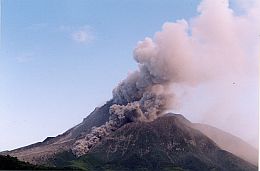| Grant Supports Research on Emissions and Seismicity at Soufriere Hills Volcano, Montserrat |
|
Abstract: The degassing behavior of a volcanic system is an integral part of the seismicity it generates. Volcanic monitoring has relied heavily on the use of seismic networks and regular measurements of sulfur dioxide degassing to evaluate the state of the magma body and the potential for future eruptions. |
These methods have helped improve understanding of magma dynamics and eruption forecasting, but have been limited by the fact that gas measurements cannot be taken at simlar temporal resolution as continuous seismicity. Thus, these methods, have remained somewhat independent of each other relaying on observing distinct changes or trends ("ramping up ") in activity as indicators of future events. However both decreasing and increasing trends in SO2 emissions may signal impending eruption, and a closer link between seismic and degassing information would give scientists and new tool with which to mitigate volcanic hazards. In January 2002, the Montserrat Volcano Observatory (MVO) installed a new gas monitoring system at Soufriere Hills Volcano (SHV) composed of two Differential Optical Absorption Spectrometers (DOAS); these new sensors allow continuous retrieval of sulfur dioxide spectra from the emitted plume, and gas flux values every 1-6 minutes over the course of a working day. These data enable, for the first time, a close merging of gas and seismic datasets.
The proposal features:
-Calibration of the timing of SO2 degassing and seismic activity, and
correlation of changes in emitted SO2 fluxes to seismic triggers from
subsurface and near-surface motions.
-Development of a magnitude scale for SHV seismic events, based on the
MOV seismic network database. This magnitude scale will be used to
constrain magnitude-frequency relationships for SHV events (long-period
and hybrid earthquakes, and rockfalls).
-Correlation of volcanic SO2 fluxes to seismic event type, magnitudes,
seismic amplitude and timing by merging the SO2 and seismic data over
active periods for SHV.
-Support for MVO's automated gas measurement system, by providing rigorous
evaluations of daily degassing fluctuations, noise, and system errors.
The intellectual merits include:
-Merging of high temporal resolution datasets will allow better understanding
of magma dynamics and evaluate current theories of volatile and seismic
characteristics.
-Improved eruption prediction capabilities, by linking gas and seismic
behavior to precursory activities in a highly active volcanic system.
Outreach and broader impacts include:
-Establishing baseline trends and methodologies for most effective uses
of gas flux data, as rapid SO2 measurement systems are incorporated into
other volcano monitoring efforts.
-Support for MVO's hazard mitigation infrastructure, through exploration
of the potential for a gas alert derived from automated gas flux data.
-Develop a stronger, long-term collaboration between Michigan Tech and
MVO, featuring student research projects.
Back To News page
Department of Geological & Mining Engineering & Sciences
Michigan Technological University
1400 Townsend Drive - Houghton, MI 49931-1295
(906) 487-2531


